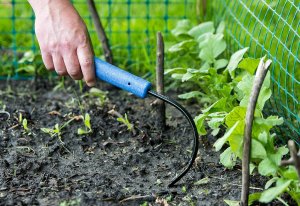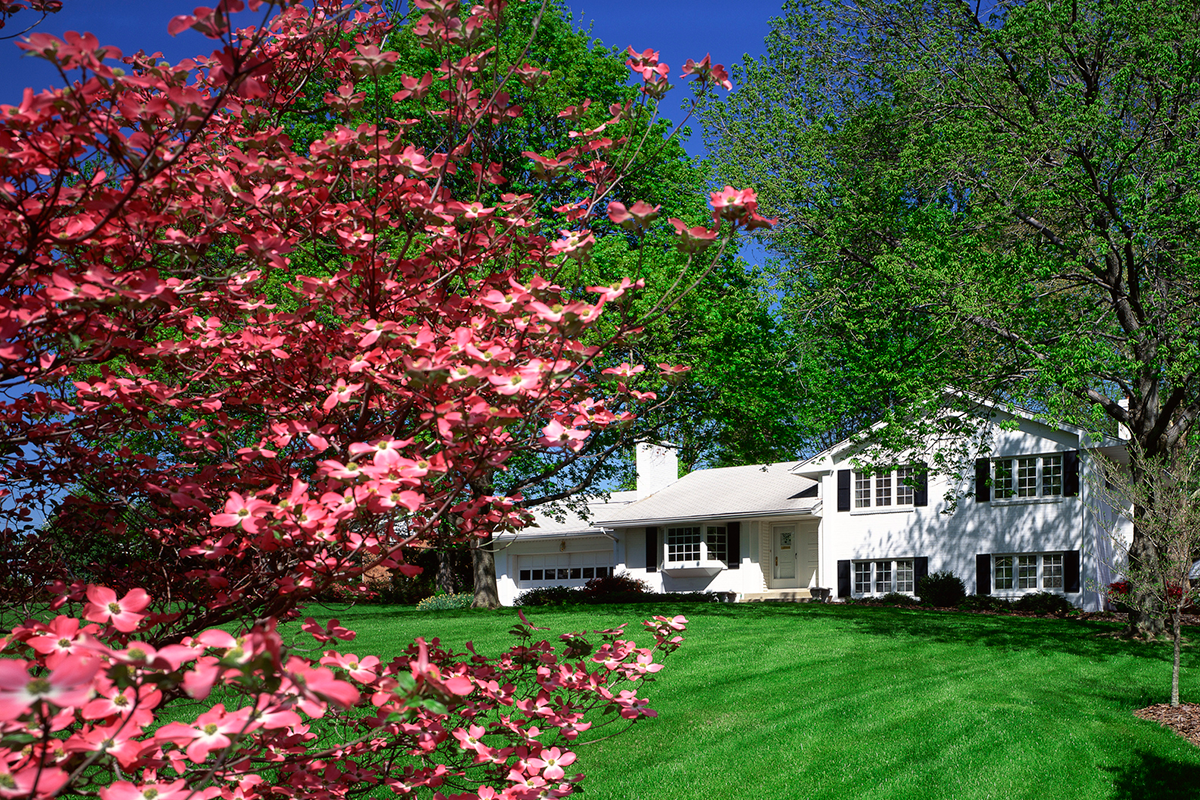

We may earn revenue from the products available on this page and participate in affiliate programs. Learn More ›
As you approach spring landscaping chores, you might be considering adding a dogwood tree to your yard. But, when do dogwoods bloom? They typically flower between early spring and early summer, depending on the species and the climate it inhabits. Many also offer colorful drupes and fall foliage after the “dog and posy” show.
Their common name may derive from dagwood—not the comic strip character but the branches once used to skewer meat. Types of dogwood trees vary from the 6- to 12-inch miniature dogwood “tree” known as bunchberry to the giant dogwood, which can reach 60 feet. Their flowers also vary from large “blooms” composed mostly of leaf bracts to tiny blooms in clusters.
1. Cornelian Cherry Dogwood or European Cornel (Cornus mas)
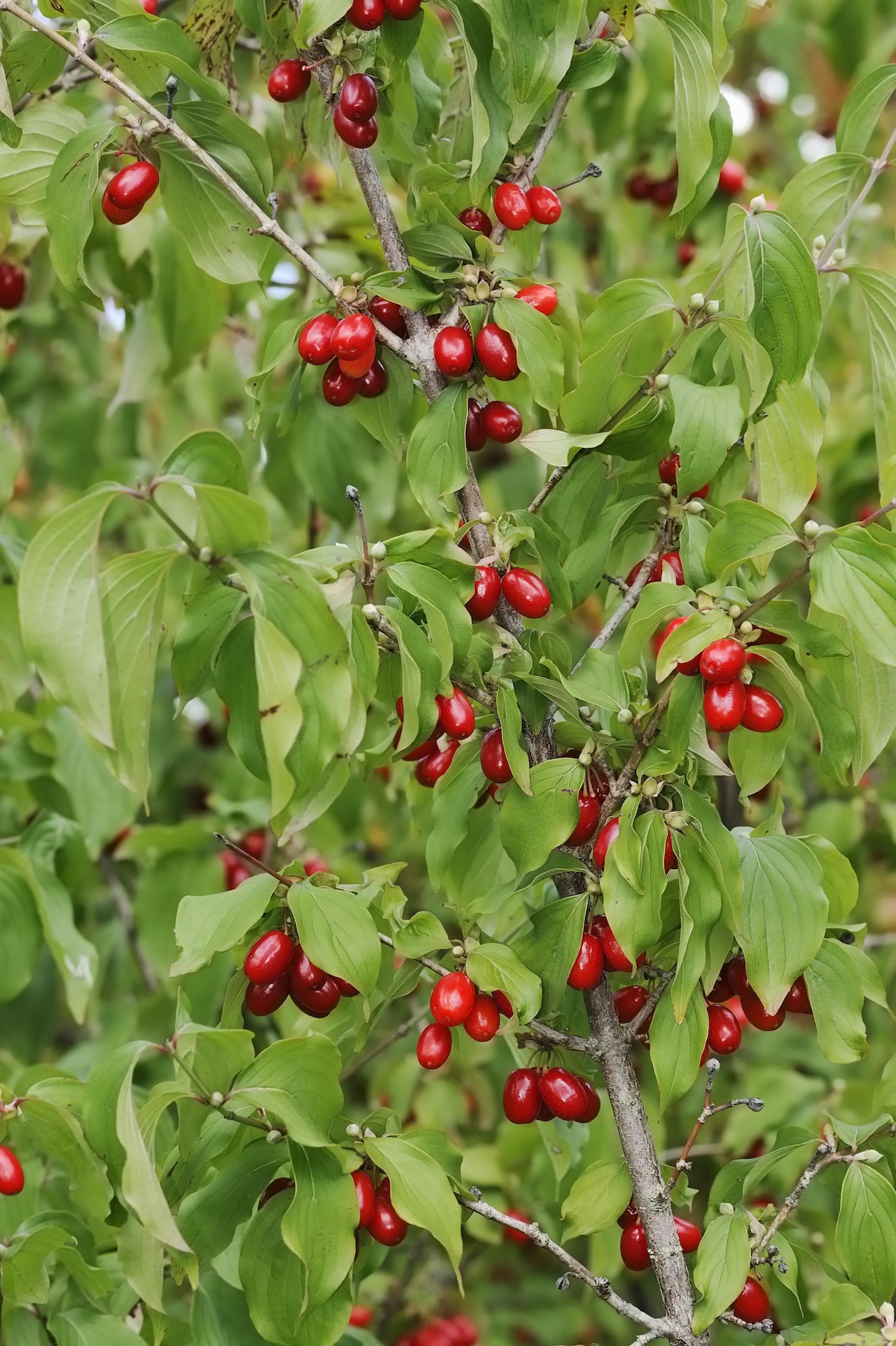
Named for its “cherries,” oblong red drupes, rather than for its flowers, the European Cornelian Cherry Dogwood can bloom during winter in the mildest areas of its range. However, it usually produces its tiny yellow flowers in small clusters in early spring before foliage appears. Its edible but tart ½ to 1 inch long fruits ripen to red in midsummer and are most often used in jellies.
This dogwood shrub has typical oval dogwood leaves whose fall color can vary from dull green to the purplish-red more common with Cornus species. It will sucker, which can be a good thing if you want a hedge, but you can prune the shrub into a tree shape instead if you prefer. Choose Golden Glory for more prolific bloom or Variegata for variegated foliage.
Hardiness Zones: 4 to 8
Mature Height: 15 to 25 feet
2. Dwarf Dogwood or Bunchberry (Cornus or Chaemaepericlymenum canadensis)
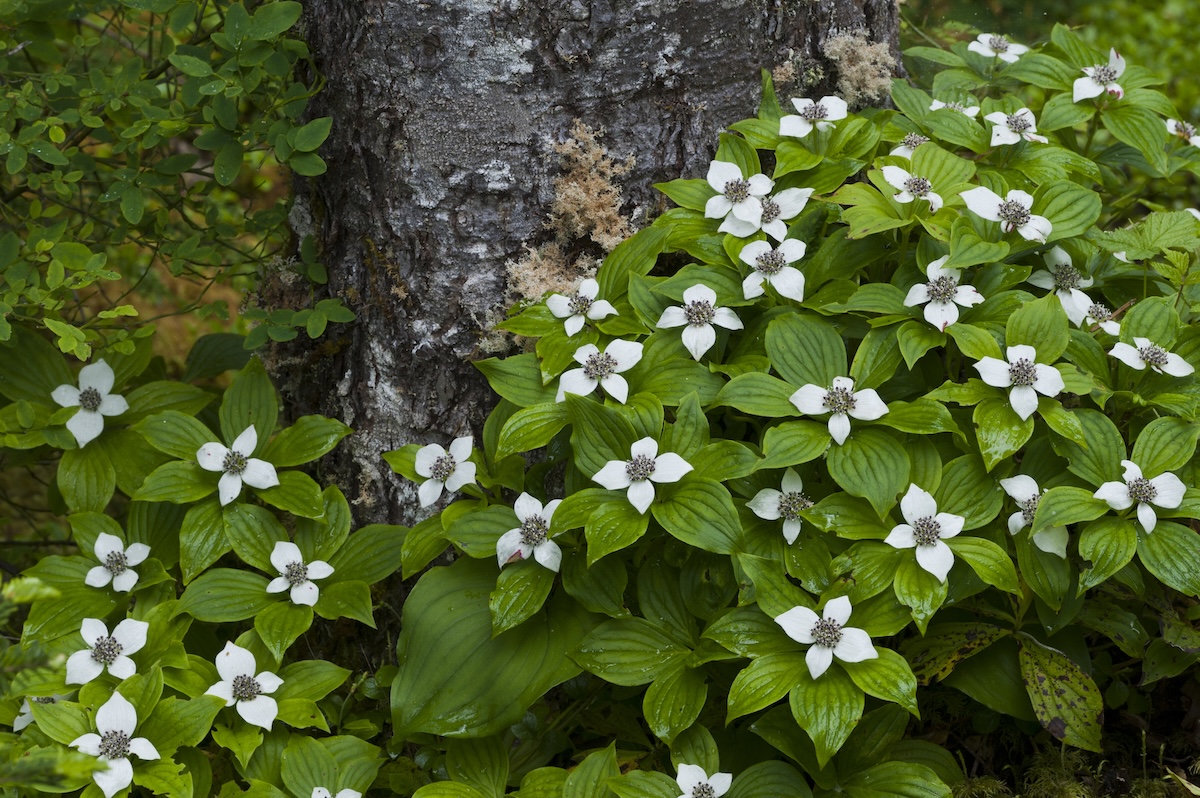
The dwarf dogwood tree isn’t actually a tree but a native woody ground cover that usually doesn’t surpass 1 foot in height. It begins to flower in late spring and sometimes persists blooming until midsummer. As with most dogwoods, its “petals” actually are colored leaf bracts—white in this case—while the true flowers are the bracts’ greenish centers.
The bracts are followed in late summer by clusters of edible ¼-inch red drupes. Bunchberry grows in either partial shade or dappled shade in a woodland-like setting where it won’t be trampled underfoot. According to Clemson Cooperative Extension, “Dogwoods prefer moist, well-drained, acidic soil that is high in organic matter.”
Hardiness Zones: 2 to 6
Mature Height: ½ to 1 foot
3. Eastern or Flowering Dogwood (Benthamidia or Cornus florida)
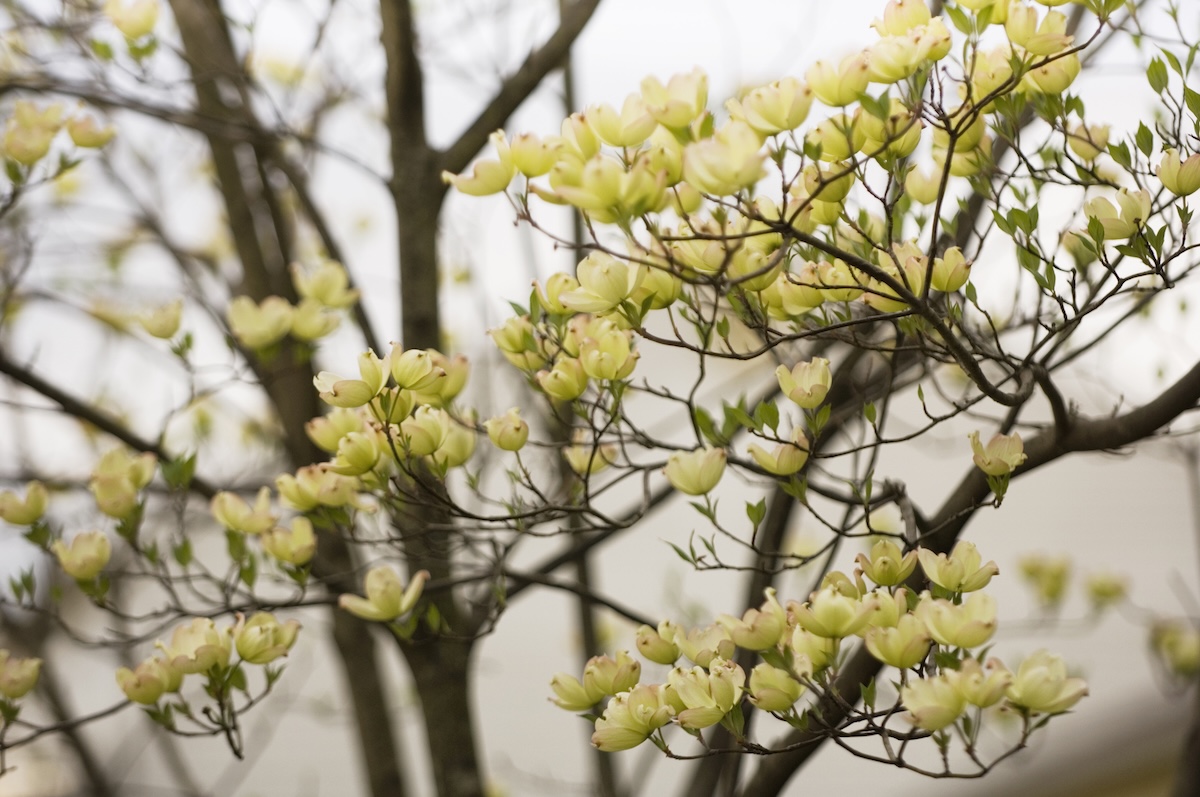
Clemson Extension notes that the flowering dogwood tree “is the species most people think of when the word dogwood is mentioned.” In other words, it is top dog! Flowering dogwood characteristics include 3- to 6-inch “blooms,” each made up of four notched white, pink, or yellow leaf bracts surrounding the true yellow-green flowers at their center.
Those “blooms” appear in mid to late spring before the trees’ leaves, followed by clusters of nontoxic but bitter drupes that redden along with the foliage in early to mid-autumn. According to Jenny Rose Carey, author of Glorious Shade, “If you are encouraging wildlife to your garden, this is a must-have tree. Birds and other animals love the fruits. I refer to them as an ‘energy bar’ for migratory birds returning to their winter residences.”
This species, which prefers partial shade, is prone to fungal diseases. Resistant cultivars include Appalachian Spring and Appalachian Joy.
Hardiness Zones: 5 to 9
Mature Height: 15 to 30 feet
4. Chinese Evergreen or Strawberry Dogwood (Cornus capitata subsp. angustata)
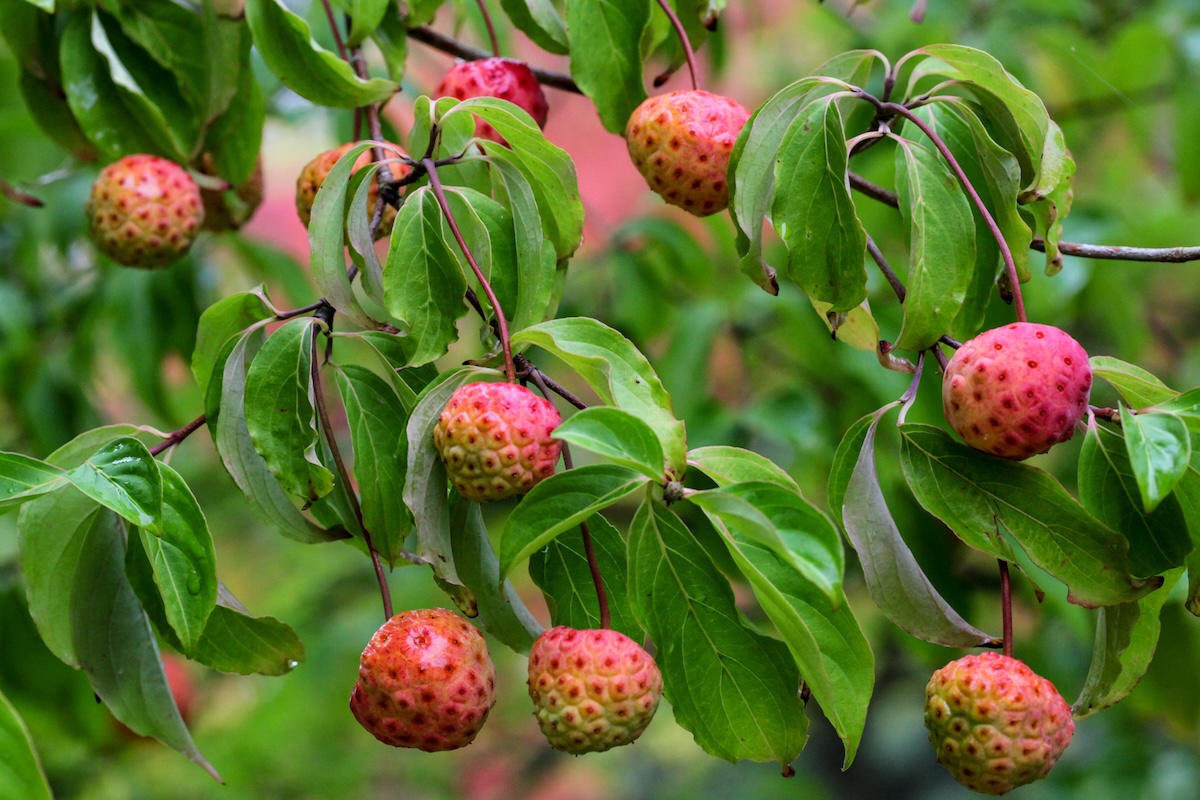
Although most dogwoods are deciduous, the leathery leaves of the Chinese Evergreen type can persist through winter in Zones higher than 6, but are more likely to turn reddish green and drop during winter in Zone 6 and lower. Its 3- to 6-inch late spring and early summer “blooms” offer un-notched leaf bracts surrounding the true yellow-green flowers, so the blooms appear more star-shaped than the earlier blooming Benthamidia (Cornus) florida’s cross-shaped ones.
This evergreen’s flowers are followed by roundish strawberry-like fruits, which ripen to red. NCSU Cooperative Extension admits that those fruits “are technically edible but are better left to the birds.” Clemson Cooperative Extension recommends “complete, acid-forming organic fertilizers” for dogwoods, applied in mid-spring and, 6 weeks later, in early summer.
Hardiness Zones: 6 to 9
Mature Height: 12 to 20 feet
5. Giant Dogwood (Cornus or Swida controversa)
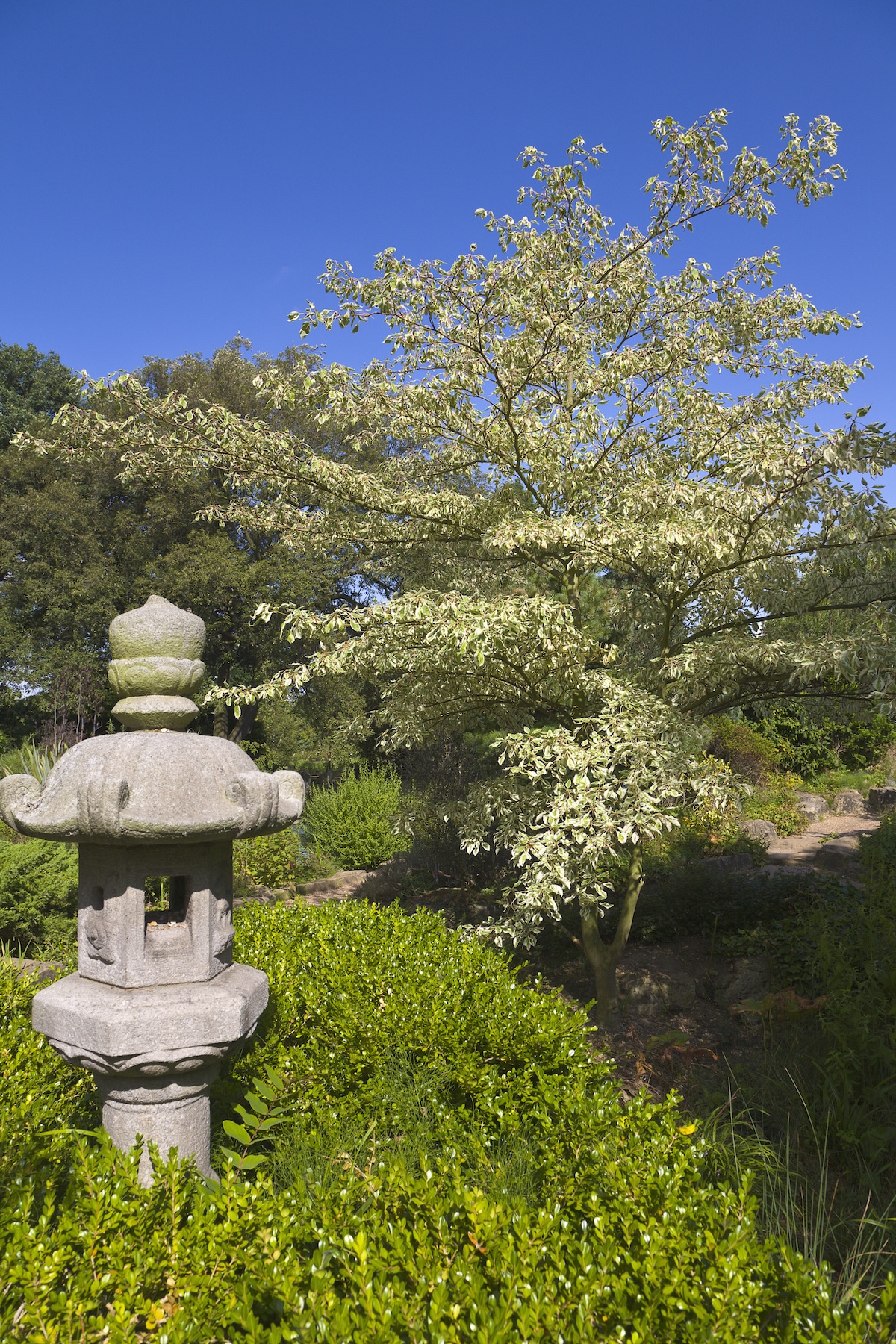
Native to the Orient and one of the tallest of the dogwood tree varieties, this species can reach 45 feet with its branches held horizontally like the tiers of a wedding cake. Its white flowers, on the other hand, are very small but produced in large 3- to 7-inch clusters in late spring to early summer, followed by blue-black fruits in late summer. Those fruits attract birds and other animals but are considered inedible for humans.
As with most dogwoods, the tree can thrive in either full sun or partial shade. For a white wedding cake look, choose the variegated cultivar (Variegata). If you prefer dark green leaves and orange/red fall color, select June Snow.
Hardiness Zones: 5 to 8
Mature Height: 35 to 45 feet
6. Kousa or Chinese Dogwood (Cornus kousa or Benthamidia japonica)
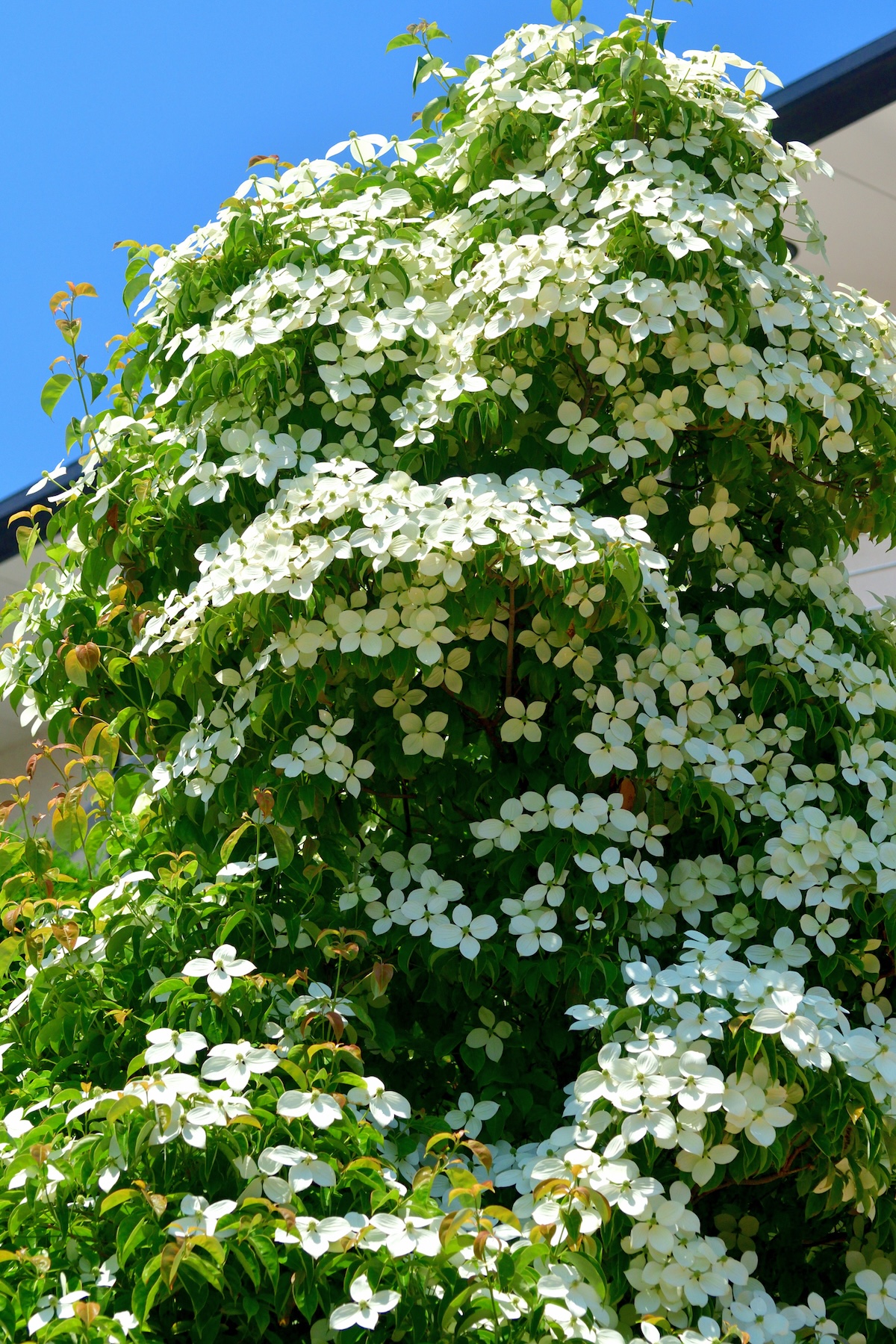
Like the eastern type, this nonnative dogwood makes 3- to 6-inch white or pink blooms. However, they have pointed rather than notched petals and appear about a month after those of Cornus florida, in late spring to early summer once the trees have leafed out. Those flowering trees also produce raspberry-like pinkish-red fruits that are edible. Their fall leaf color varies from purple to red to yellow. Kousa is more sun-loving than the eastern dogwood and also more disease-resistant, making it one of the most vigorous dogwood flowering trees.
For that reason, Chinese dogwood often has been crossed with C. florida to produce cultivars that offer the best traits of both species. Purely kousa cultivars include the variegated dogwood tree Summer Fun, as well as Moonbeam, which has unusually large 7-inch flowers.
Hardiness Zones: 5 to 8
Mature Height: 20 to 30 feet
7. Pacific or Western Dogwood (Cornus nuttallii)
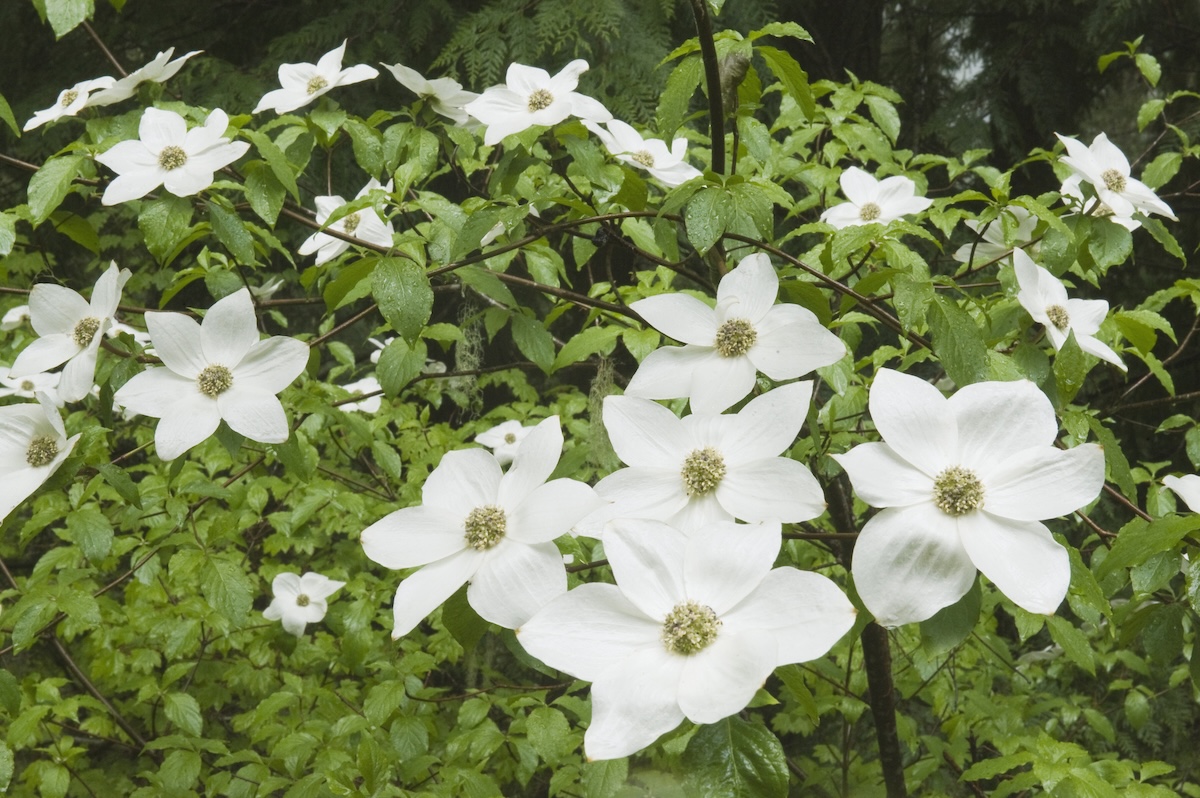
The western dogwood native to the Pacific Northwest and California resembles the eastern one, but it is less hardy, and its “blooms” often offer six to eight white pointed leaf bracts—rather than four notched ones—clustered around the greenish or purplish true flowers at the center. It also may bloom twice, once in spring before the tree leafs out and again in late summer or fall, with flowers up to 6 inches across. Of its pinkish-red fruit, Calscape notes that “Though edible, it is not very palatable.’
Unfortunately, the western dogwood shares the eastern dogwood’s vulnerability to anthracnose and also often is crossed with C. kousa for greater disease resistance. Fall foliage may be yellow, red, or pink. Cultivars include Colrigo Giant with 6-inch flowers and the yellow variegated Goldspot.
Hardiness Zones: 7 to 9
Mature Size: 15 to 40 feet
8. Pagoda Dogwood (Cornus or Swida alternifolia)
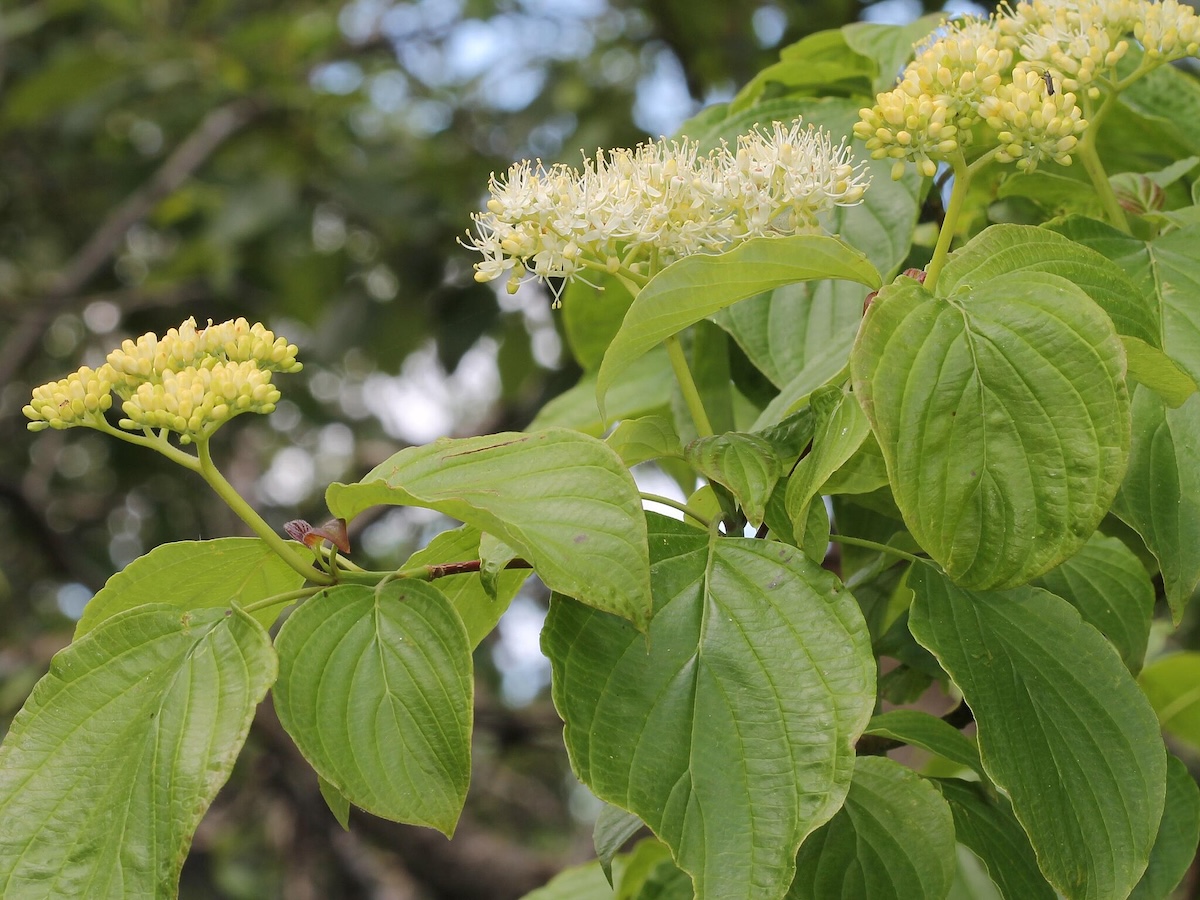
Except for the fact that it is native to North America, the pagoda dogwood might be considered a shorter version of the Oriental giant dogwood. It too offers tiered branches and tiny white blooms in clusters in late spring and early summer followed by bitter blue-black berries in mid to late summer and red foliage in autumn.
The Pagoda dogwood generally tops out at about 25 feet and its flower clusters measure only about 2 to 3½ inches across. So, this small dogwood tree fits into the backyard landscape more easily than the giant one does. Its variegated cultivars include Argentea and Golden Shadows.
Hardiness Zones: 3 to 7
Mature Height: 15 to 25 feet
9. Redtwig or Red Osier Dogwood (Cornus or Swida sericea or stolonifera)
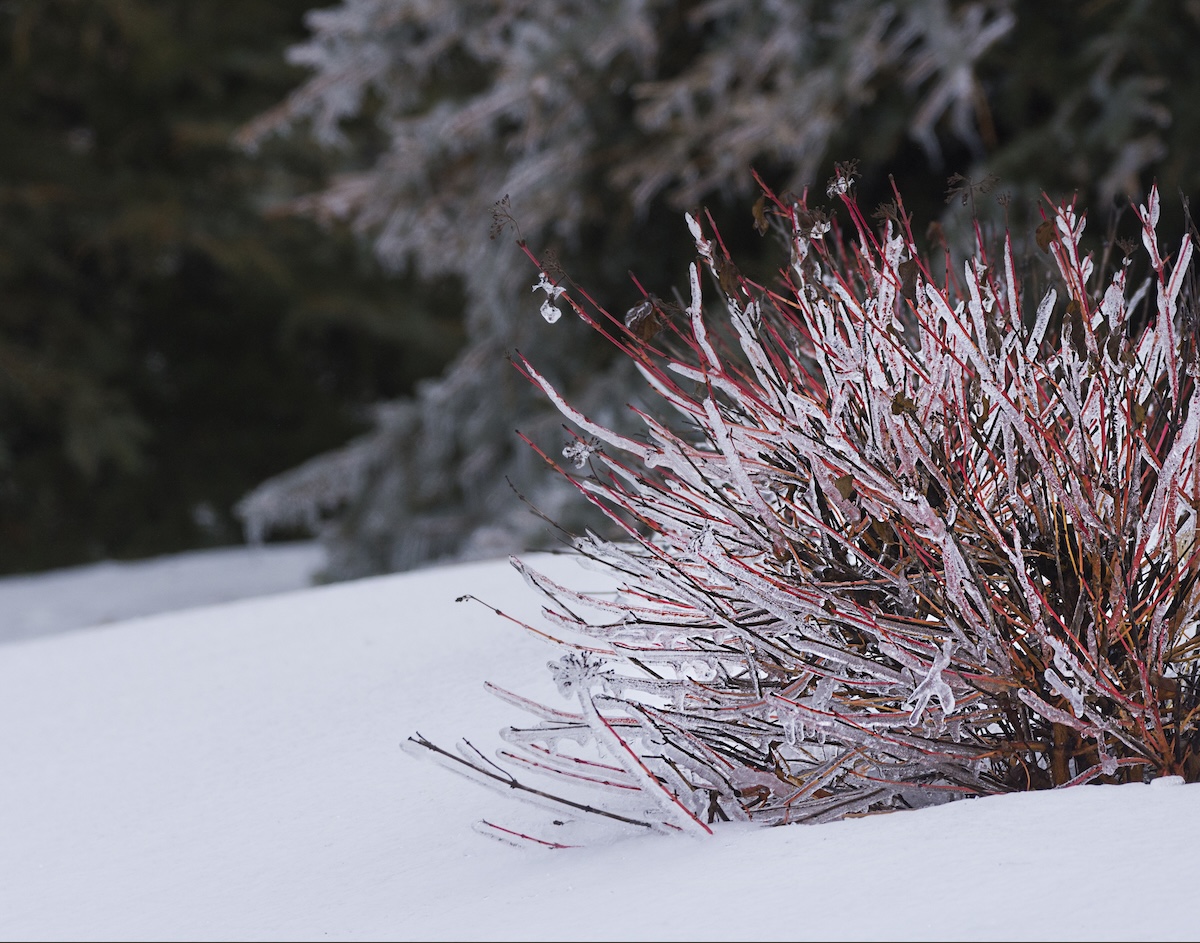
Popular as a winter shrub for its red stems that stand out against the snow (though a few cultivars offer yellow stems instead), this osier is native to North America and typically inhabits somewhat boggy locations. Therefore, it may make a good choice for a poorly draining area of your yard where nothing else will grow.
This dogwood bush produces clusters of small white flowers in late spring and early summer followed by bitter drupes in late summer. According to North Carolina Extension, the edible white fruits with blue tinge “are attractive to birds and hold even more ornamental value than the flowers.” Also ornamental is the red or orange fall foliage which darkens to purple. This fast-growing shrub tends to spread rapidly via underground stems, so it could become invasive if not kept in check. Choose Baileyi for particularly vivid red stems, or Flaviramea for golden-yellow stems.
Hardiness Zones: 2 to 7
Mature Height: 5 to 9 feet
10. Tatarian or Red-Barked Dogwood (Cornus or Swida alba)
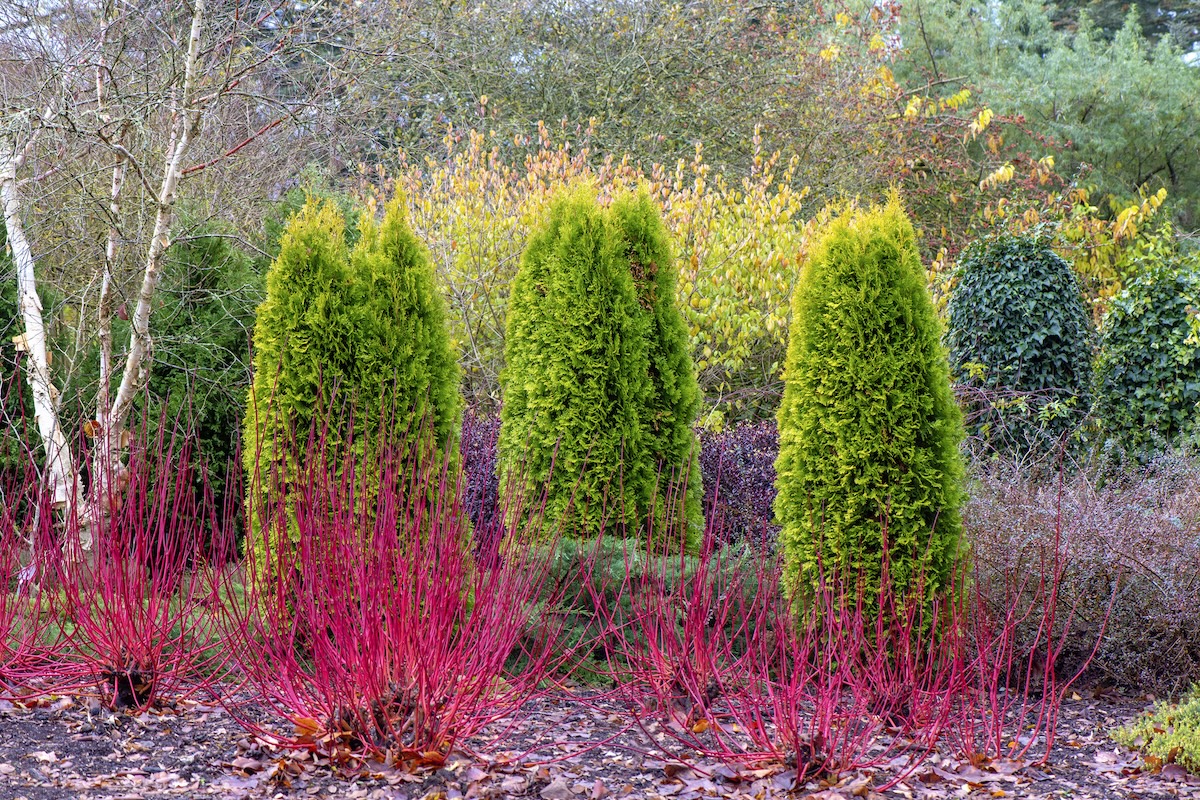
Tartarian Dogwood might be called the Asian form of Redtwig Dogwood, since it shares most of the characteristics of that species, including the red stems, clusters of white flowers, and white drupes. In both species, younger stems offer the reddest hues, so it’s a good idea to remove about a fourth of the older ones in spring for better color in winter. Both can be used as either full sun shrubs or partial shade shrubs.
Missouri Botanical Garden agrees that Tatarian dogwood is similar in appearance to redtwig dogwood, “but generally does not spread as aggressively.” Cultivars of this dogwood shrub include the variegated Elegantissima and the smaller-than-usual Sibirica, whose height tops off at about 7 feet.
Hardiness Zones: 3 to 7
Mature Height: 8 to 10 feet
